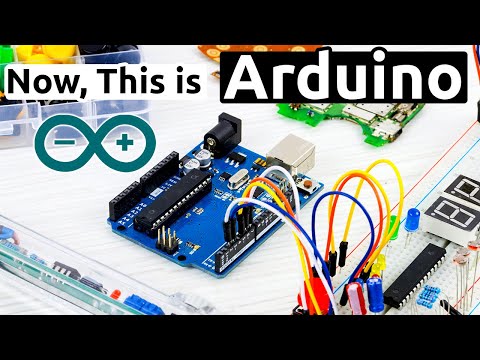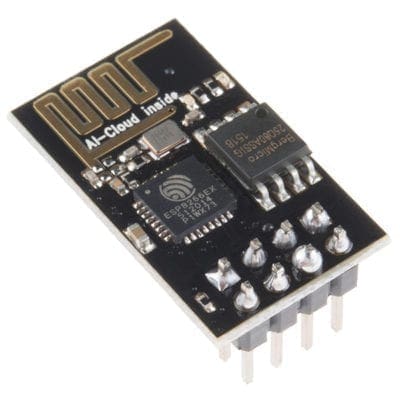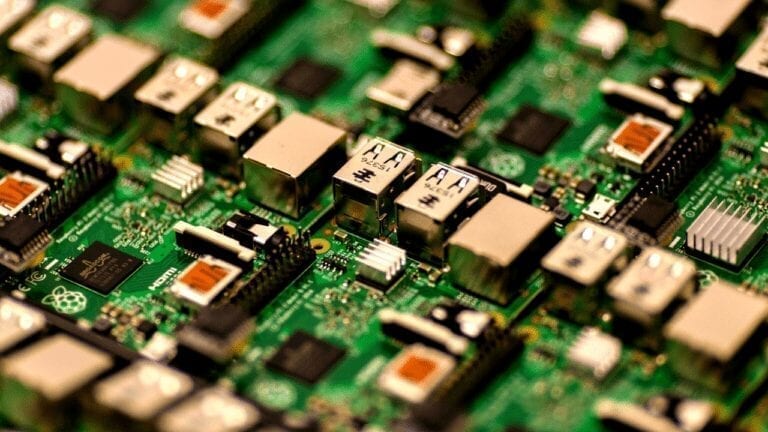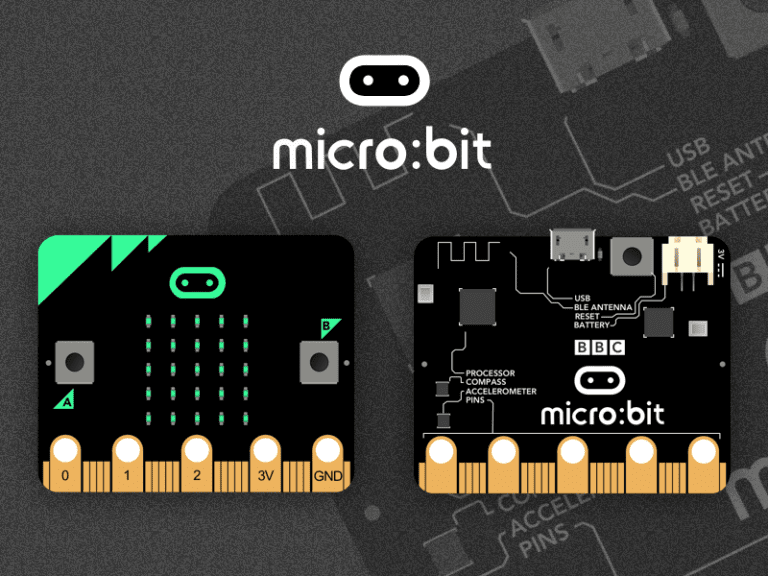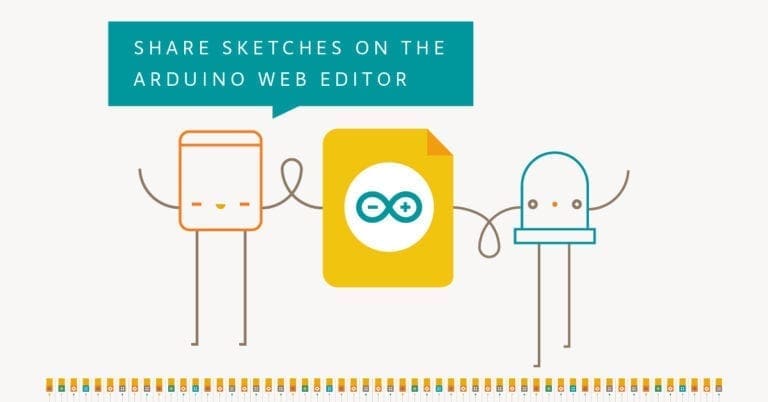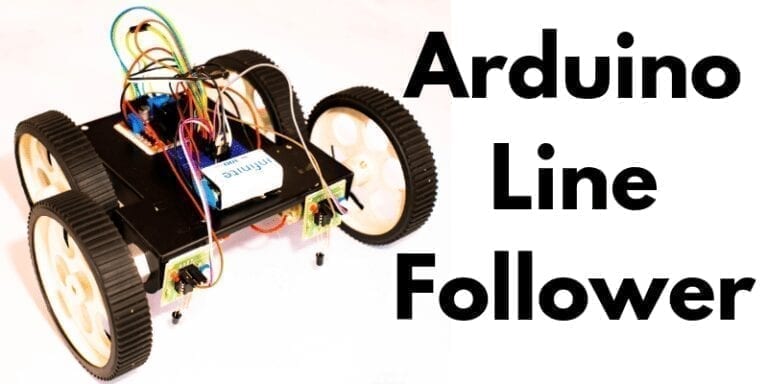Must-Have Electronics Kits and Components to Start Learning DIY Electronics & Robotics
Electronics Kits for Beginner DIY Robotics and Electronics Enthusiasts
When getting started with electronics and practicing the basics, choosing the right components is crucial to ensure a smooth and enjoyable learning experience. As a beginner, it’s essential to focus on common and widely used components that are readily available and well-documented. Components like resistors, capacitors, LEDs, transistors, and integrated circuits are great choices as they are fundamental building blocks of electronic circuits. Starting with these components allows beginners to explore various circuit configurations, understand their properties, and learn how they interact with each other.
So lets start our journey..
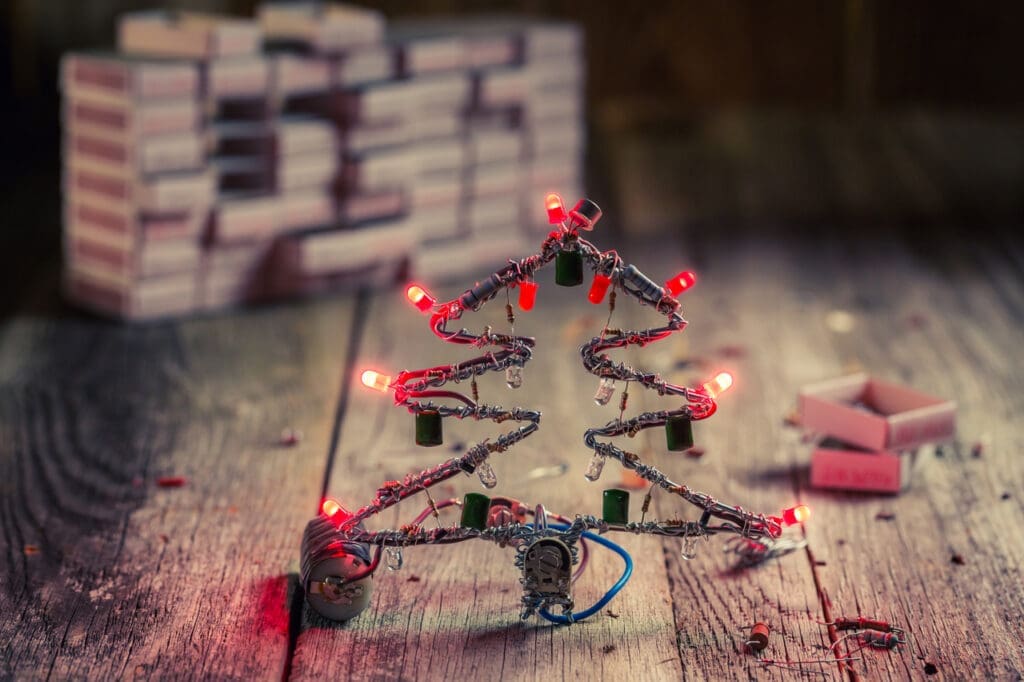
Another consideration when selecting components is their ease of use and handling. Through-hole components, which have leads for easy insertion into breadboards or soldering, are ideal for beginners. Surface Mount Devices (SMD) can be more challenging to work with, so it’s better to leave them for later stages of learning. Additionally, beginners should consider buying components in starter kits or assortments. These kits often include a variety of components, resistors, capacitors, and more, providing a cost-effective and convenient way to get a diverse collection of parts for experimentation. As beginners become more familiar with different components, they can gradually expand their collection based on their interests and project requirements, allowing them to take on more complex and exciting challenges in the future.
Basic Electronics Components you need to get started with Robotics and Electronics
Bread Board for Building Circuits
A breadboard is an easy-to-use and practical instrument for creating an electronic circuit. It is a plastic board that is rectangular in shape and has several tiny holes all over it. These holes are used to introduce electronic components into a prototype electronic circuit. The breadboard features a lot of tiny, hole-like sockets that are organized in a 0.1 grid. For beginners working on electronics projects, a breadboard is a necessity since it offers a simple platform for testing out and developing electronic circuits without the use of solder.
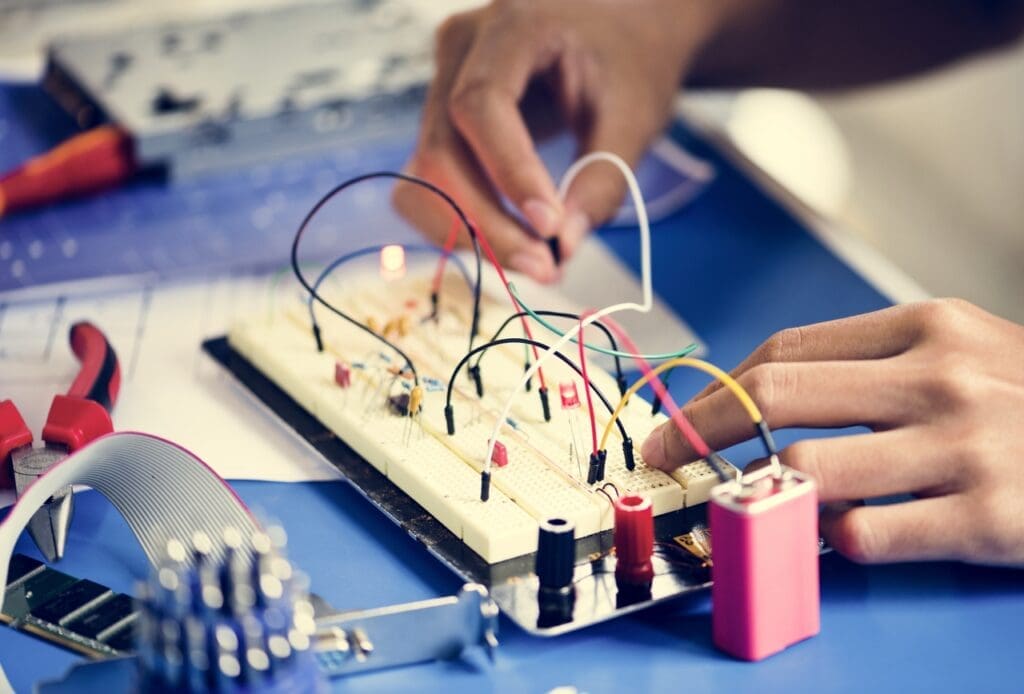


A breadboard can assist beginners in electronics projects in the following ways:
- Ease of Use: Breadboards are created to be user-friendly and don’t need any specialized knowledge or equipment to use them. The grid of interconnected sockets on the breadboard makes it simple to input components, enabling rapid and hassle-free circuit building.
- No Soldering: For novices who might be unsure about soldering procedures, breadboards offer a solderless option. This removes the chance that components will be harmed by shoddy soldering and makes circuit reconfiguration simple.
- Component Testing: Breadboards make it simple to test different electronic components, such as transistors, integrated circuits, integrated capacitors, and resistors, before permanently integrating them into a project.
- Experimentation and Learning: Newcomers can test out numerous component combinations, experiment with various circuit topologies, and gain practical knowledge of electronics concepts. Understanding circuit design and troubleshooting benefits from this hands-on learning approach.
- Reusable and reconfigurable: The breadboard is an affordable option for prototyping and experimenting since components can be simply removed and reused on it for new applications.
- Quick Prototyping: A breadboard is an excellent platform for quickly prototyping electronic ideas before going on to the more long-lasting soldered solutions because beginners can quickly create and change circuits on it.
- Safety: Since no soldering is necessary, there is a lower possibility of accidental burns or other injuries, making it a safer solution, especially for novice or young electronics hobbyists.
- Less Component Damage: Soldering occasionally exposes delicate electrical components to extreme heat, which could harm them. This risk is removed when using a breadboard, enabling risk-free testing and experimentation.
- Visualization: Users can see the connections and current flow in the circuit thanks to the breadboard’s architecture, which makes it easier to comprehend and debug.
- Breadboards frequently contain several power rails and distribution strips, making it simple for users to build parallel circuit branches.
- Flexibility: Due to the wide range of sizes available for breadboards, beginners can select one to match the level of complexity of their projects, from modest and straightforward to larger and more complex ones.
Breadboards offer a secure, adaptable, and practical platform for learning, experimenting, and prototyping electronic circuits without the need for soldering, making them an essential tool for novices in electronics projects. Anyone seeking to delve into the fascinating realm of electronics will find it to be a fantastic place to start.
Connecting Wires for Interconnecting Components
A part of an electrical circuit that carries current is called a conducting wire. It is constructed using a material that conducts current, such as copper or tungsten. An insulating substance, such as rubber, is placed over the wire for protection and to prevent current loss. In a circuit, conducting wires are represented by various colors to indicate their purpose. In most cases, red is the live wire, black is the neutral wire, and green is the grounding wire.
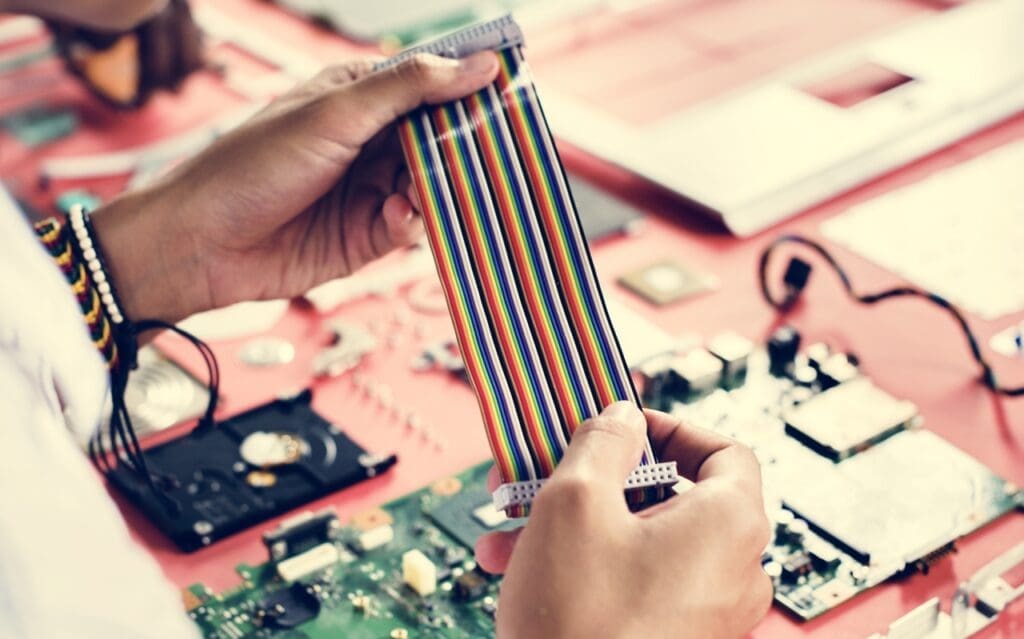

In electronics projects, connecting wires are essential because they make electrical connections between different circuit components. In order for the circuit to work as planned, these wires serve as conductors, allowing current to pass from one device to another. In an electronics project, the following are the main functions of joining wires:
- Electrically Connecting Components: The major function of connecting wires is to create electrical connections between various components, including sensors, integrated circuits, integrated circuits, transistors, capacitors, resistors, and capacitors. The circuit paths created by these connections allow an electric current to flow.
- Finishing the Circuit: For current to flow in any electronic circuit, a closed loop is necessary. In order to ensure that electricity may move from the power source, through the components, and back to the source, connecting wires helps close the loop.
- Signal routing: In increasingly sophisticated electrical projects, connecting wires are utilized to move signals from one region of the circuit to another. This is crucial in circuits with numerous stages or parts that must communicate with one another.
- ower Distribution: Connecting wires are in charge of transmitting power from the power source, such as a battery or power supply, to various circuit components that need electricity to operate.
- Grounding: For reference potential and noise reduction in electronic circuits, grounding is crucial. Wire connections aid in creating the ground connection, which provides a reliable baseline for voltage levels.
- Signal Transmission: The wires that join components have the capacity to transmit both electricity and signals. Signal wires are used in electrical circuits to carry data, instructions, or other types of information.
- Connections made on a breadboard: As was noted in the previous response, temporary connections between components are made on breadboards during prototyping and experimenting.
- Flexibility and Adaptability: Connecting wires enables circuit design and modification flexibility and adaptability. To adapt to modifications in the circuit’s design or component placement, they can be simply altered, changed, or moved.
- Subsystem interconnection: In more complicated electronic systems, connecting wires help link together various subsystems to make sure they perform properly as a whole.
- Connecting wires play a crucial function in isolating defective parts or circuit portions during testing and troubleshooting of electronics projects, making it simpler to spot and fix problems.
The physical conduits that allow current and signals to move between parts of an electronics project are known as connecting wires. They give the circuit the appropriate electrical paths, ensuring that it operates properly and serves the desired purpose. Any electronic project’s success depends on the wires being connected and arranged properly.
Resistors for Controlling Current
A resistor is a type of electrical device that resists the flow of current. It is a passive device used to restrict or obstruct the passage of electric current in an electric circuit by creating resistance and causing a voltage drop across the device. The Greek letter capital omega () stands for the ohm value of a resistor, which is expressed in electrical resistance.
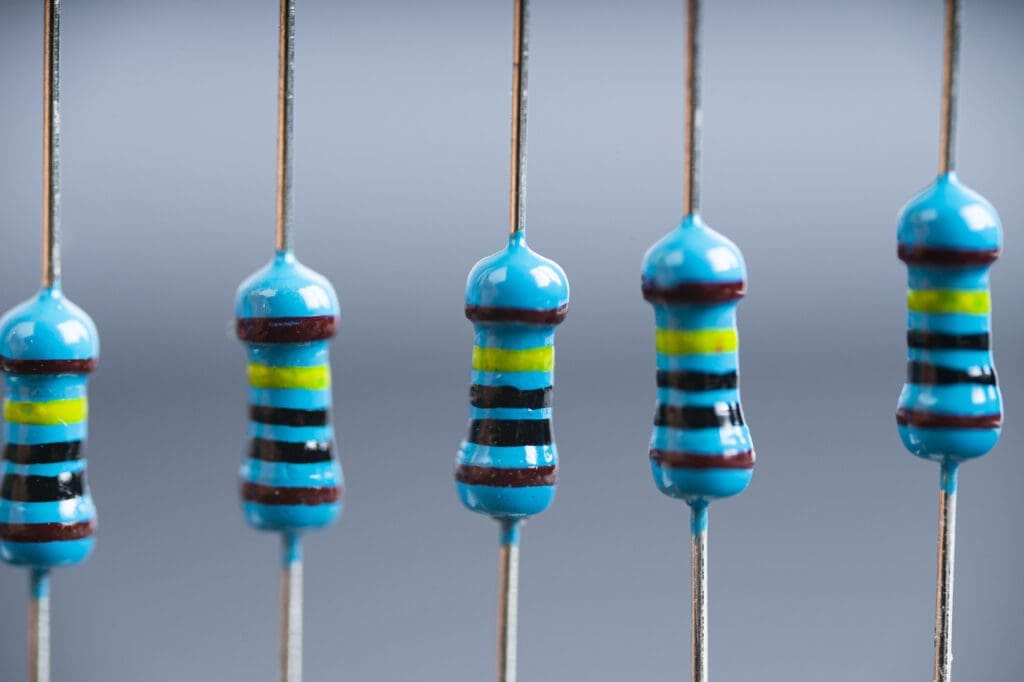

A resistor can be made in a variety of ways. Some are simply a coil of wire constructed of cheap conductor material. The most popular method involves the use of powdered carbon and a glue-like binder. Analog or digital multimeters are commonly used tools for measuring resistance. It is not necessary to measure the actual resistance of the circuit in order to do a resistance measurement. Rather, the voltage and current applied to the circuit are measured in order to determine resistance. A voltage drop is displayed by the circuit when a current is delivered to the circuit being measured. Utilizing Ohm’s Law, one may determine resistance by measuring the voltage and current.
Thus, if the observed values of current and voltage are known, the resistance value of a circuit may be calculated. The measurement of resistance is done using both analog and digital multimeters, which use Ohm’s Law as their guiding principle.
Capacitors
A capacitor is essential for beginner DIY electronics enthusiasts because it acts like a tiny, temporary battery that can store and release electrical energy quickly. This little electronic component is incredibly useful in various projects. It can smooth out electrical signals, filter out unwanted noise, and help control the timing in circuits. For beginners, capacitors are great for learning about how different components interact in a circuit and how they can impact performance. They are easy to use, inexpensive, and come in different values, allowing beginners to experiment and gain hands-on experience while building exciting projects like LED flashers, sound generators, and more.
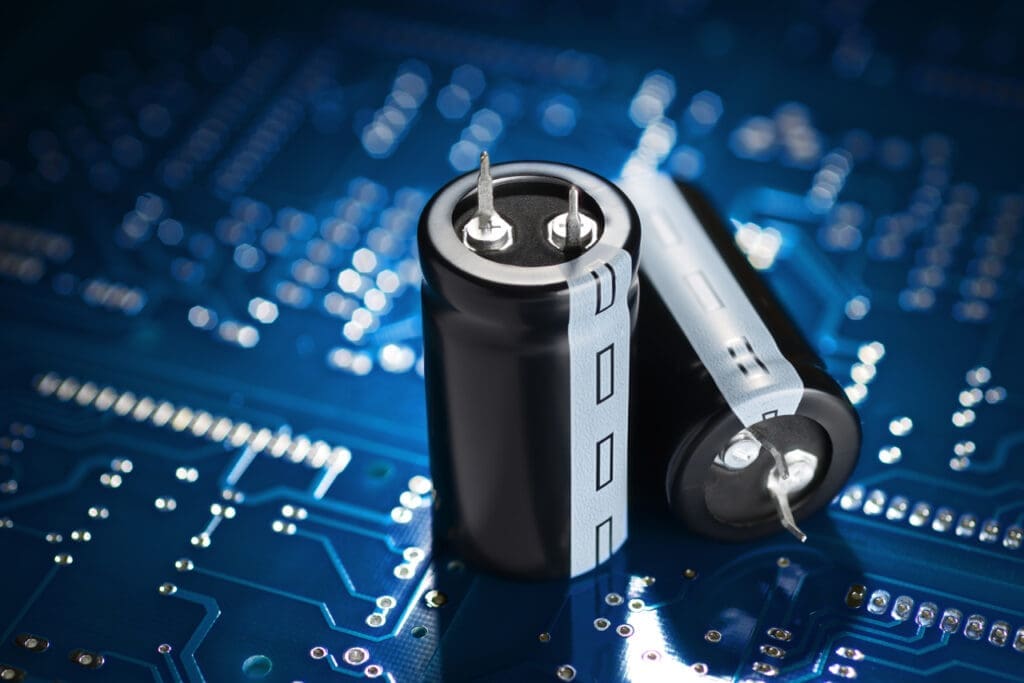

They can help beginner DIY electronics enthusiasts learn about the basic concepts of electronics. Imagine a bucket that can hold water temporarily, and when you pour water into it, it collects and stores the water. Similarly, a capacitor stores electrical charge. Learning about capacitors can teach beginners how they can control the flow of electricity, store energy, and affect the behavior of electronic circuits. Capacitors are used in various projects, from simple LED flashers to more complex devices. Understanding capacitors is a fundamental step in electronics, and it opens the door to exploring other components and building exciting projects. So, get your hands on some capacitors, start experimenting, and have fun learning electronics!
LED Kit for Testing Outputs
In simple terms, LEDs (Light-Emitting Diodes) are tiny lights that glow when electricity passes through them. They are great tools for beginner DIY electronics enthusiasts because they are easy to use, safe, and can teach important electronics concepts. Beginners can learn about basic circuit connections by connecting LEDs to batteries or power sources on a breadboard. When they see the LED light up, it gives them a sense of accomplishment and helps them understand how electricity flows in a circuit.
LEDs come in different colors, which allows enthusiasts to experiment with different components and create colorful and fun projects. As they progress, they can explore more advanced concepts like resistors, transistors, and microcontrollers to control LEDs and create exciting electronic gadgets and displays.


The importance of using LEDs for learning electronics lies in their simplicity and effectiveness as educational tools. They provide a hands-on and visual way to grasp fundamental electronic principles without being overwhelming. By experimenting with LEDs, beginners build confidence in handling electronic components, understanding circuits, and troubleshooting. LEDs also pave the way for learning more complex topics in electronics, making the learning journey enjoyable and engaging. Furthermore, as LEDs are used in various real-world applications, such as lighting, displays, and indicators, understanding their behavior becomes foundational knowledge for anyone pursuing a deeper understanding of electronics or a career in STEM-related fields.
Diode
a diode is like an electronic one-way valve that allows current to flow in only one direction. For beginners in DIY electronics, understanding diodes is essential because they are one of the fundamental building blocks of many electronic circuits. Diodes are used for tasks like converting alternating current (AC) to direct current (DC), protecting components from reverse voltage, and even building simple logic gates. Learning about diodes helps enthusiasts grasp basic electronics principles like current flow, voltage regulation, and signal rectification, which form the foundation for more complex projects.
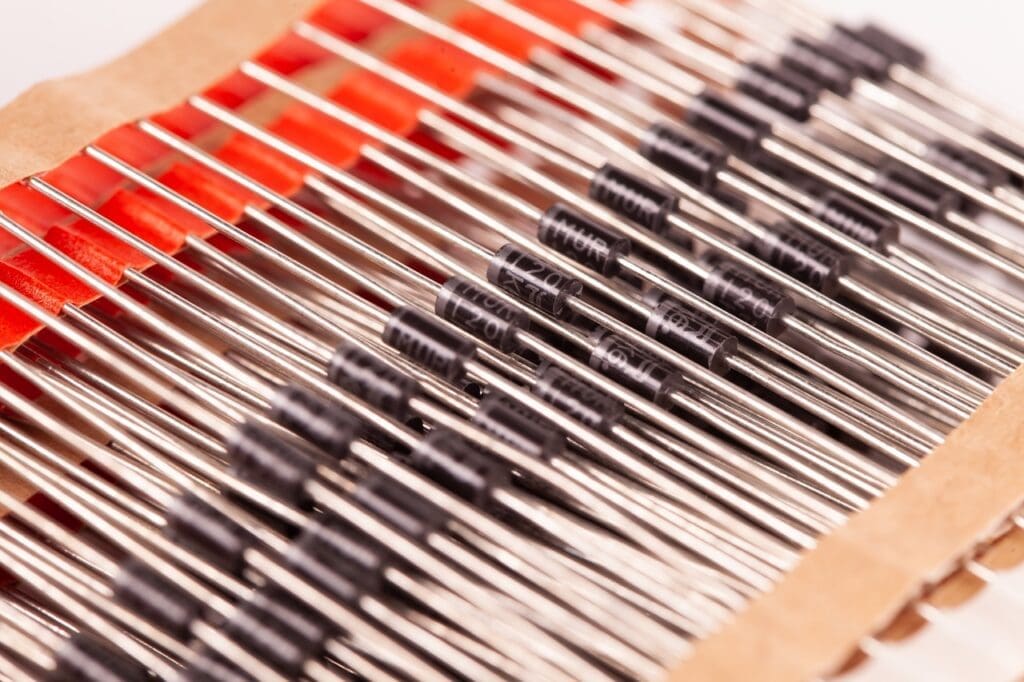

The importance of diodes in electronics lies in their versatility and widespread usage. As DIY electronics enthusiasts progress to more sophisticated projects, diodes become a fundamental component in various circuit designs. They are vital in power supplies, radio receivers, LED circuits, and much more. Understanding diodes opens the door to a wide range of electronic applications, and it allows enthusiasts to explore, experiment, and innovate in their projects with confidence. Learning about diodes sets the stage for a deeper understanding of electronics and empowers beginners to take on more challenging and exciting projects as they continue their journey into the world of electronics.
Buzzer – Beep Beep
Buzzers are excellent components for beginner DIY electronics enthusiasts to learn and understand electronics principles. In simple terms, a buzzer is an electronic device that makes a buzzing or beeping sound when you apply an electric current to it. By connecting a buzzer to a power source and other components like switches or microcontrollers, beginners can explore fundamental concepts like circuit connections, voltage, and current flow. They can experiment with different setups to control when the buzzer sounds, creating various sound patterns and understanding how different components interact to produce sound.
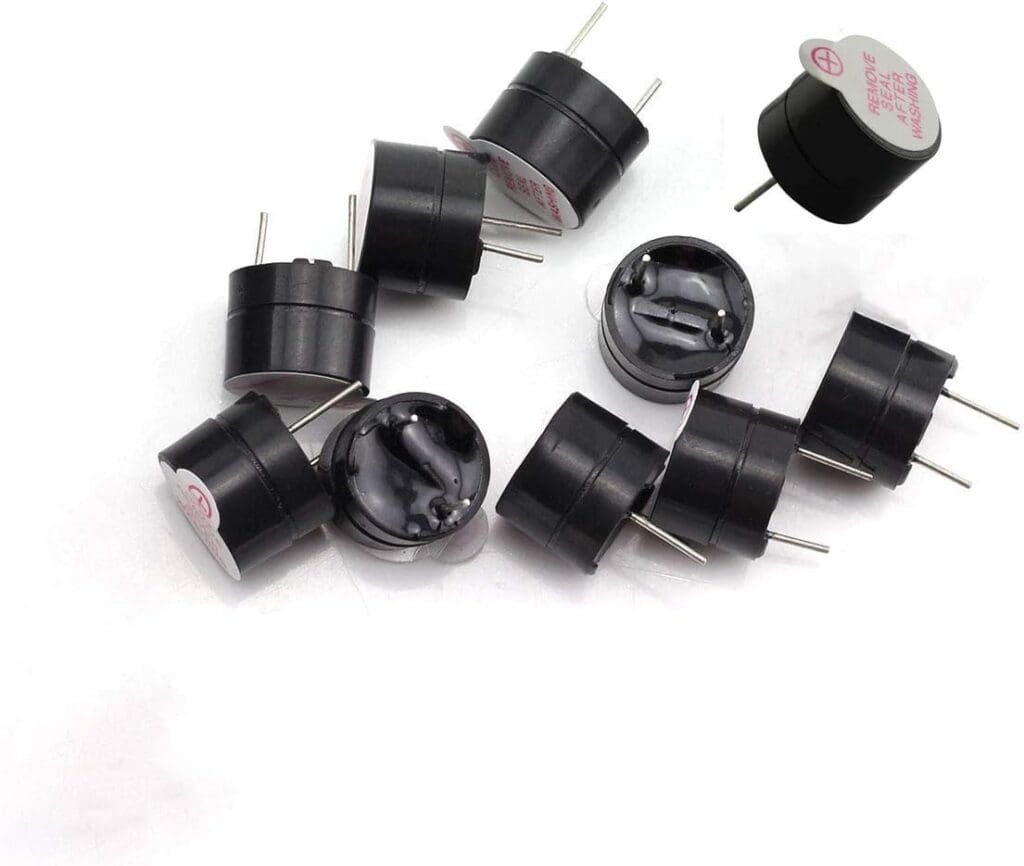

The importance of using buzzers in electronics learning lies in their simplicity and versatility. Buzzers provide instant feedback to beginners, making it rewarding to see their circuit creations come to life with sound. Through this hands-on experience, beginners grasp core concepts more effectively. Additionally, buzzers are commonly used in various real-world applications, like alarm systems and electronic devices, so understanding how to work with them lays a foundation for more complex projects. Overall, buzzers make electronics engaging, fun and help enthusiasts build the knowledge and confidence to tackle more advanced electronic projects in the future.
Multimeter – Measure Everything
A multimeter is like a magic tool for beginner DIY electronics enthusiasts! It’s a simple device with a screen and a few buttons that can measure electricity in different ways. It’s like having X-ray vision for electronics! With a multimeter, you can measure voltage (how much electrical force is pushing through a circuit), current (how much electricity is flowing), and resistance (how much a component resists the flow of electricity).
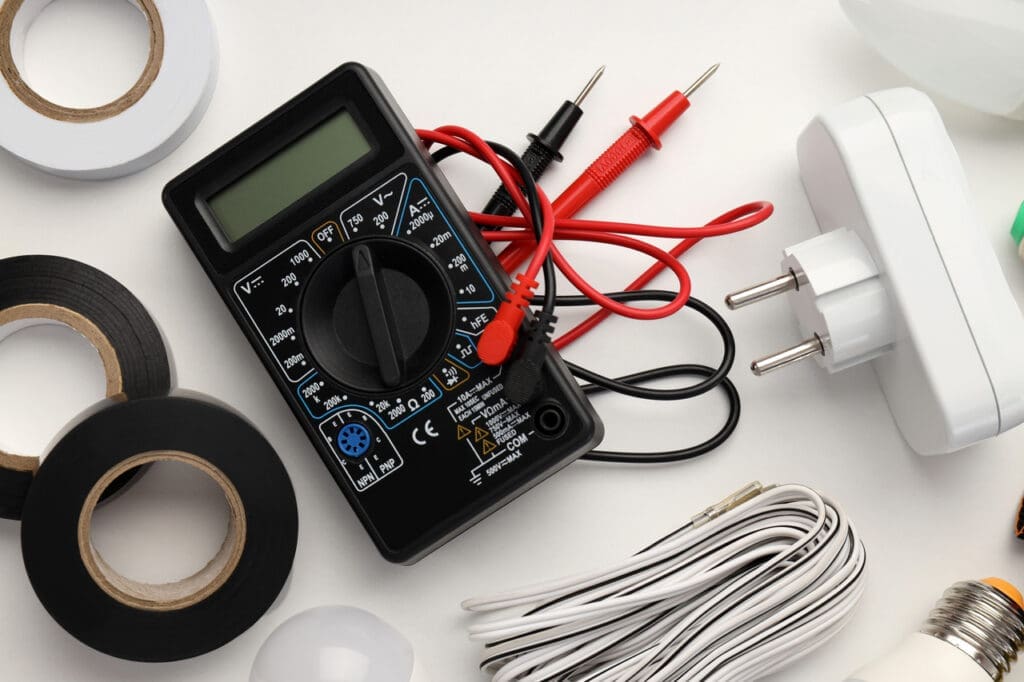

By using the multimeter, beginners can understand how different components behave, check if they are working correctly, and troubleshoot problems in their projects. It’s like having a detective’s magnifying glass for electronics, helping you unlock the secrets of circuits and become an electronics wizard! A multimeter is incredibly important for DIY electronics enthusiasts because it’s the key to understanding and mastering electronics. It’s a versatile tool that empowers beginners to experiment and learn.
By measuring voltage, current, and resistance, you can confirm if your circuit is behaving as expected, locate faults, and make improvements. It’s like having an electronic teacher by your side, guiding you through the learning process. Without a multimeter, you’d be like a chef without a taste tester – you won’t know if your creation is turning out as planned or if it needs adjustment. So, for any DIY electronics journey, a multimeter is an essential companion that will boost your confidence, enhance your skills, and turn you into a pro!
9V Battery – Portable Power Supply for your Circuit
A 9V battery is like a small portable power source that can provide electricity to electronic projects. For beginner DIY electronics enthusiasts, it’s an essential tool because it’s safe and easy to use. You can connect wires and components to the battery without soldering, making it simple to experiment with different circuits and learn how electronics work. With a 9V battery, you can power simple projects like LED lights, buzzers, and small motors, which helps you understand the basic principles of electronics and see the results of your work immediately. It’s like a hands-on learning tool that sparks your curiosity and creativity, setting the foundation for more complex projects in the future. Plus, as it’s a low-voltage battery, there’s minimal risk of electric shock, making it safe for beginners to start their electronics journey.



In summary, a 9V battery is an excellent learning tool for beginner DIY electronics enthusiasts because it’s safe, easy to use, and can power simple projects. It allows beginners to experiment with circuits and components, helping them understand the fundamentals of electronics in a practical and engaging way. By using a 9V battery, beginners can build confidence, gain hands-on experience, and lay the groundwork for more advanced projects in their electronics journey.
Adapter –
A 12V DC adapter is like a handy power source that can make learning electronics much easier and safer for beginner DIY electronics enthusiasts. It acts as a simple and stable source of electrical energy, providing a constant 12 volts of direct current (DC) that you can use to power your electronic circuits and projects. This means you won’t have to worry about finding and connecting batteries to your circuits, which can be cumbersome and unpredictable. Instead, you can focus on understanding how components work together and experiment with various circuit designs, all while having a reliable power supply at your disposal.


Having a 12V DC adapter is essential for beginners because it ensures a stable and controlled power input to your circuits. This stability is crucial for preventing accidental damage to sensitive components due to incorrect voltages or fluctuations. By using a DC adapter, you can confidently explore different electronic components, like resistors, capacitors, LEDs, and sensors, and see how they behave when connected in various ways. Moreover, it’s a safer option than using batteries, as there’s no risk of them running out of power or leaking. Overall, a 12V DC adapter simplifies the learning process, enhances the reliability of your experiments, and allows you to focus on the fundamental concepts of electronics without worrying about power issues.
Soldering Iron
A soldering iron is like a tool that helps beginner DIY electronics enthusiasts build and create electronic projects. It looks like a pen with a hot tip that can melt a special metal called solder. With a soldering iron, you can attach electronic components together on a circuit board to make things like blinking LED lights, buzzers, or even robots! It’s like using glue to stick things together but for electronics.
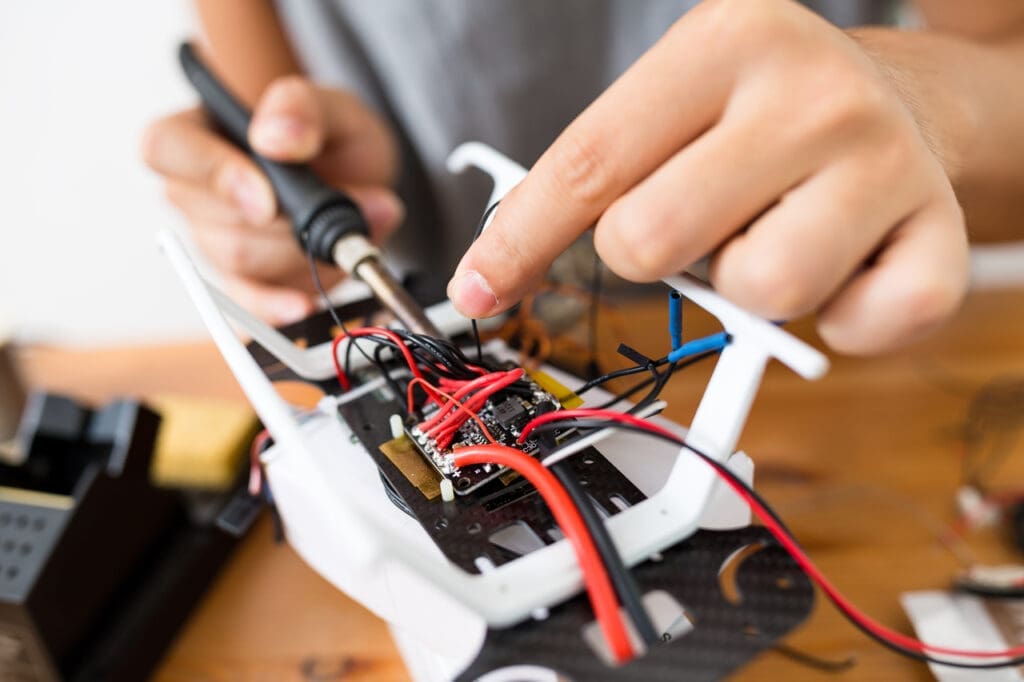

This magical tool is essential because it allows you to create more permanent and sturdy connections between components, making your projects reliable and functional. It also opens up a whole new world of possibilities, as you can work with a wide range of electronic parts to bring your ideas to life. So, if you want to level up your DIY electronics skills and turn your ideas into real gadgets, a soldering iron is a must-have companion on your electronic adventures!
In summary, a soldering iron is a vital tool for beginners in DIY electronics. It helps them create strong and lasting connections between electronic components, allowing for the construction of functional projects. With a soldering iron, beginners can explore a wide range of electronic possibilities and bring their ideas to life, making it an essential tool for any electronics enthusiast’s toolkit.
Why is it important to learn the basics of Electronics?
Learning and practicing the basics when getting started with electronics is of paramount importance for aspiring enthusiasts. The basics lay the foundation upon which all future knowledge and skills are built. Understanding fundamental concepts such as Ohm’s law, voltage, current, and resistance enables beginners to comprehend how electronic components interact and how circuits function. Without a solid grasp of these fundamentals, more advanced topics can become overwhelming and confusing. Moreover, practicing the basics through hands-on experimentation and prototyping allows beginners to develop essential problem-solving and troubleshooting skills. As they work with simple circuits, they gain the confidence and experience needed to tackle more complex projects in the future.
Additionally, learning and practicing basics in electronics fosters creativity and innovation. Once beginners have a firm understanding of the fundamentals, they can start to explore and experiment with different components, circuit configurations, and applications. This experimentation often leads to unique and novel projects, sparking a passion for electronics and inspiring further exploration. Additionally, having a strong grasp of the basics makes it easier to adapt and work with new technologies and advancements that emerge in the ever-evolving field of electronics. In conclusion, the importance of learning and practicing the basics when starting with electronics cannot be overstated. It forms the cornerstone of knowledge, confidence, and creativity, empowering enthusiasts to pursue their passion, build exciting projects, and continue to grow as electronics enthusiasts.
How can I learn the basics of DIY Electronics and Robotics?
If you’re eager to dive into the fascinating world of electronics and robotics, look no further! Check out our comprehensive tutorials on the basics of electronics and robotics, designed specifically for beginners. These tutorials offer a step-by-step approach, guiding you from scratch to help you grasp the foundational concepts. You’ll learn about essential components, such as resistors, capacitors, and transistors, and understand how they work together to create electronic circuits. With clear explanations and hands-on examples, you’ll quickly gain confidence in constructing your own projects.
Our robotics tutorials will take you on an exciting journey into the realm of intelligent machines. Starting from the fundamentals of robotics, you’ll learn about sensors, motors, and microcontrollers, discovering how to program robots to perform specific tasks. Whether you’re interested in building simple robots that follow lines or more advanced autonomous machines, our tutorials will equip you with the knowledge and skills needed to bring your robotic creations to life. So, if you’re ready to embark on an educational and inspiring adventure, check out our tutorials on the basics of electronics and robotics today, and unlock the endless possibilities of these captivating fields!
Conclusion – Basic Electronics Kit for DIY Electronics and DIY Robotics Engineers
In conclusion, choosing the right components for practicing basics in electronics is crucial for a successful learning journey. Focusing on widely used and easily accessible components provides a solid foundation for understanding electronic circuits. Starting with through-hole components and utilizing starter kits or assortments helps beginners get hands-on experience, build confidence, and pave the way for more advanced projects as they progress in their electronics knowledge and skills.

